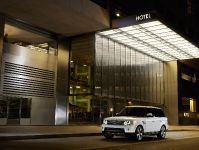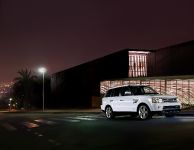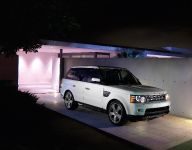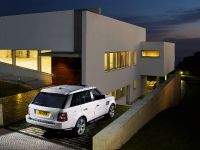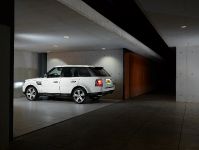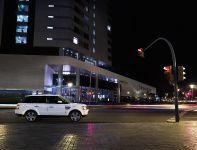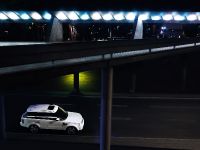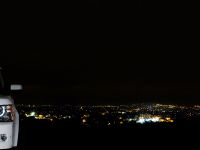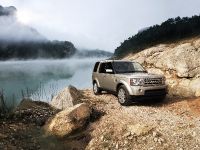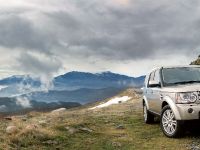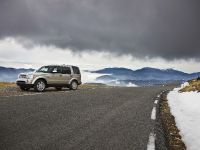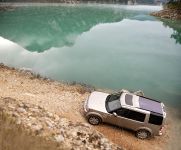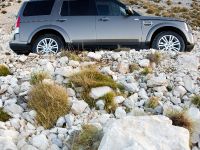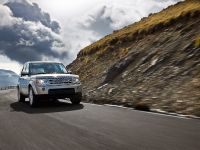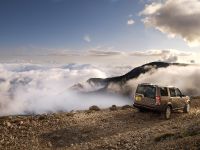2010 Range Rover Sport And Discovery 4
The new 2010 Range Rover Sport and Discovery 4 combine world beating performance, capability and luxury with reduced CO2 emissions thanks to a stunning new engine and transmission line up. Inside, we've moved the game on too, with some innovative new technologies and all-new interiors. Phil Popham, managing director
New engines redefine performance and economy Land Rover is introducing two new engines for the 2010 model year following a joint development programme with Jaguar. The LR-TDV6 3.0-litre diesel engine alongside the LR-V8 Supercharged petrol engine set new benchmarks for performance and economy, boasting substantial increases in power and torque over their predecessors as well as lower emissions and reduced fuel consumption.
The class-leading LR-TDV6 3.0-litre betters the already impressive 2.7-litre diesel by 29 percent (power) and 36 percent (torque) respectively. At 600Nm the torque output of the diesel is thought to be the highest of any six-cylinder passenger car diesel in the world, but with nine percent improvements in economy and CO2 emissions over the 2.7-litre V6.
The LR-V8 supercharged petrol engine is no less impressive, packed with innovative technical features enabling it to match supreme performance with extreme efficiency. Power and torque is considerably improved over the existing V8 supercharged petrol engine. For example, as fitted to the Range Rover Sport the new 5.0-litre supercharged engine produces 29 percent more power and 12 percent more torque than the outgoing 4.2-litre engine, yet CO2 emissions and fuel consumption are improved by 5.6 percent and 6.2 percent respectively.
Other engines available The brand new engines will be supplemented by a choice of well proven existing power units. In addition to the new LR-TDV6 3.0-litre, customers will still have the option of ordering the Discovery GS model with the acclaimed 2.7-litre TDV6. The Range Rover Sport will be available with the new LR-TDV6 3.0-litre, the existing 3.6-litre TDV8 or the new LR-V8 5.0-litre supercharged petrol engine.
World class transmissions offer greater refinement and economy The Range Rover Sport (and also the Range Rover) is fitted with the super-smooth ZF HP28 6-speed automatic transmission, tuned by Land Rover engineers to combine class-leading response with rapid, refined shifting. The outstanding low-end torque characteristics of the new engines have made it possible to actuate the transmission's lock-up clutches earlier in each gear, reducing slip through the hydraulic torque converter to improve both CO2 emissions and fuel economy.
e_Terrain Technologies boost economy and reduce CO2 Both the diesel and petrol engines were designed from the outset to deliver class-leading fuel economy and enhanced low-end torque. The parallel sequential turbo-charging system of the LR-TDV6 3.0-litre makes use of a larger, primary turbo most of the time. The smaller secondary turbo remains dormant when higher power is not required, reducing pumping losses and fuel consumption.
On the LR-TDV6 3.0-litre, a third generation common rail injection system with piezo injectors and an energy-saving fuel metering system, also make a substantial contribution to fuel economy, while a reduction in idle speed from 750rpm to 710rpm compared to the 2.7-litre diesel further reduces fuel consumption and emissions without compromising refinement.
Similarly, every detail of the highly advanced new supercharged V8 engine has been designed to return maximum efficiency. A new high pressure, spray guided direct injection system optimises combustion while a new variable camshaft timing system helps deliver exceptional low-end torque while also helping to maximise fuel efficiency at both ends of the rev range.
The LR-V8 5.0-litre is also equipped with a new, sixth generation, twin-vortex supercharger whose high-helix rotor design improves its thermodynamic efficiency by 16 percent. Faster warm-up thanks to a new, reverse flow cooling system further improves fuel economy as do the low friction design features on both engines. Like the LR-TDV6 3.0-litre, idle speed has been reduced compared to previous petrol engines, from 700 to 600rpm.
Vehicle dynamics move up a notch – on and off road A new Adaptive dynamics system for Range Rover Sport (and Range Rover) is the world's first production system using model-based predictive technology to continually optimise the settings of DampTronic Valve Technology™ damper units, optimising body ride and control. A refinement to the understeer control on all models helps slow the vehicle automatically if taking a bend too fast, enhancing driver control. Responding to driver steering inputs, the system will in extreme cases intervene using the brakes. A Roll Stability Control system will implement wheel-specific braking if an imminent rollover is detected. Adaptive Cruise Control is also fitted.
The Range Rover Sport and Discovery 4 also benefit from Trailer Stability Assist, a towing aid which detects trailer oscillations and intervenes using the brakes and by reducing engine torque.
Both Range Rover Sport and Discovery 4 have further improvements to the award winning Terrain Response system for 2010. Revisions to the rock crawl programme reduce roll when traversing boulders delivering a more composed ride through rocky terrain. The addition of a new 'sand launch control' prevents wheels digging in when driving away in soft sand thanks to revisions to the traction control system. The acclaimed Hill Descent Control system has also been enhanced with the addition of Gradient Release Control. This inhibits the initial rate of acceleration making descent of very steep inclines much smoother.
Design/interiors Subtle but striking exterior changes characterise the new 2010 model year Land Rovers. Smooth, sculpted, frontal surfaces with revised bumpers incorporating anti-drag lips, create a more distinctive look while improving aerodynamics and fuel consumption. Grilles are restyled too, and headlights include both LED running light technology and High Beam Assist, which switches on the lights when ambient light levels are low, and dips headlights automatically when oncoming traffic is detected. New 19 and optional 20-inch wheels are available for the Discovery which also has larger brakes as standard.
Both the Range Rover Sport and the Discovery 4 interiors have been comprehensively restyled from the ground up, featuring new facias, doors, seats, consoles, instruments and switchgears and new steering wheels. Both cars are also now fitted with 5-inch TFT screens in the instrument cluster displaying key information, a new Portable Audio Interface with MP3 player and i-Pod connectivity, and other key technology features including a five-camera surround system for ease of parking and manoeuvring.
